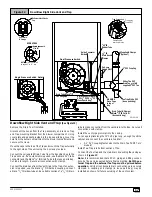
4
440 01 2020 01
vices that are designed to turn the furnace off and prevent it from
restarting in the event of various potentially unsafe conditions.
If your furnace remains off for an extended time, the pipes in your
home could freeze and burst, resulting in serious water damage.
Water may create a condition in which mold can grow in your home.
Certain types of mold have been reported to cause respiratory
problems or other serious health risks. Remedial actions, including
immediately drying all wet items, should be taken quickly to help
prevent the development of mold in your home.
If the structure will be unattended during cold weather you should
take these precautions.
1. Turn off the water supply to the structure and drain the water
lines if possible and add an antifreeze for potable water to
drain traps and toilet tanks. Open faucets in appropriate
areas.
--or--
2. Have someone check the structure frequently during cold
weather to make sure it is warm enough to prevent pipes
from freezing. Instruct them on a service agency to call to
provide service, if required.
--or--
3. Install a reliable remote sensing device that will notify some-
body of freezing conditions within the home.
Winter Shutdown
If you go away during the winter months and do not leave the heat
on in your home, the plastic transition box and the condensate trap
on the furnace must be protected from freeze damage.
(See
NO TAG
trough
NO TAG)
1. Disconnect the
5
/
8
²
OD rubber hose from the vent drain fit-
ting that is located downstream of the combustion blower. In-
sert a funnel into the hose and pour four(4) ounces of
sanitary type (RV) antifreeze into the condensate trap. Re-
connect the
5
/
8
²
OD rubber hose to the stub on the vent drain
fitting. Secure with the hose clamp.
2. Disconnect the
3
/
4
²
OD rubber hose from the condensate
trap. Insert a funnel into the hose and and pour four(4)
ounces of sanitary type (RV) antifreeze into the plastic Tran-
sition box. Squeeze the hose together near the end and
quickly reconnect the
3
/
4
²
OD rubber hose to the stub on the
condensate trap. Secure with the hose clamp.
When you return home, your furnace will be ready to start, as it is
not necessary to drain the antifreeze from the furnace.
2. Installation
CARBON MONOXIDE POISONING HAZARD
Failure to properly vent this furnace or other appliances can
result in death, personal injury and/or property damage.
This furnace can NOT be common vented or connected to
any type B, BW or L vent or vent connector, nor to any
portion of a factory--built or masonry chimney. If this
furnace is replacing a previously common-vented furnace,
it may be necessary to resize the existing vent and chimney
to prevent oversizing problems for the other remaining
appliance(s). See
Venting and Combustion Air Check
in
Gas Vent Installation
section
.
This furnace MUST be vented
to the outside.
!
Location and Clearances
4. Refer to
Figure 1
or
Figure 2
for typical installation and
basic connecting parts required. Refer to
Figure 4
for typi-
cal horizontal direct vent installation and basic connecting
parts required. Supply and return air plenums and duct are
also required.
5. If furnace is a replacement, it is usually best to install the fur-
nace where the old one was. Choose the location or evalu-
ate the existing location based upon the minimum clearance
and furnace dimensions (
Figure 3
).
CAUTION
Special precautions MUST be made if installing furnace in an
area which may drop below freezing. This can cause improper
operation or damage to equipment. If furnace environment
has the potential of freezing, the drain trap and drainline must
be protected. The use of electric heat tape or RV antifreeze is
recommended for these installations. (See
“Condensate Trap
Freeze Protection Section”)
Do NOT operate furnace in a corrosive atmosphere
containing chlorine, fluorine or any other damaging
chemicals. Refer to
Combustion & Ventilation Air section,
Contaminated Combustion Air.
Vent Pipes MUST be
supported
Horizontally and
Vertically
*8
²
Min.
20
¢
Max.
in same atmospheric
zone
*8
²
Min.
20
¢
Max.
in same
atmospheric
zone
Coupling on ends
of exhaust pipe.
Total pipe & cou-
pling
outside
structure = 8
²
Figure 1
Typical Upflow Installation
Aluminum or non--rusting shield recommended.
(See Vent Termination Shielding for dimensions).
*
Increase minimum from 8
²²²²
to 18
²²²²
for cold climates (sustained temperatures
below 0
°°°°
F).
DI
SCHARG
E
AI
R
25--23--33
I
nlet Pipe
(not used on
Single Pipe
model)
Summary of Contents for 9MPT050F12A
Page 46: ...46 440 01 2020 01...





































